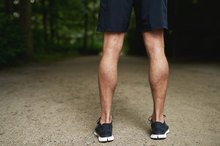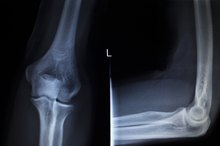Does Stretching Make You Thin?
Stretching alone cannot make you thin. But stretching does contribute to body thinness on three levels: elongation of muscle bulk for a thinner appearance; increased flexibility for greater range of motion and more effective exercise; and injury prevention to reduce the chances of interruption of physical activity. The kind of stretching that contributes to a thin body is not a warm-up or cool-down exercise, but a workout in its own right.
The Value of Stretching
A regular stretching regimen can loosen up your limbs -- which improves your range of motion -- and increases circulation throughout your body. These benefits contribute to an overall improvement in physical performance and your ability to engage in aerobics and resistance training for weight loss -- and a thinner you.
How Stretching Works
Hyperextension of the Calf
Learn More
Muscles are made of layers of thick and thin myofilaments, some of which overlap. These fibers have an elastic quality, with the ability to contract and elongate. Stretching lengthens and aligns muscle fibers for less bulk and a thinner appearance. To achieve the lengthening effect of a stretch, you must hold a stretch until the muscle's natural reaction to contract -- or return to its initial status -- is relieved and the muscle relaxes.
- Muscles are made of layers of thick and thin myofilaments, some of which overlap.
- These fibers have an elastic quality, with the ability to contract and elongate.
Static Stretches
Do static stretches by extending a muscle or muscle group until you feel slight discomfort, but not pain. Apply resistance by pulling against the muscle, as in bending forward and holding your foot to stretch your hamstring and calf muscle, or use another person or an object to apply resistance. Hold the stretch without bouncing for 10 seconds to 2 minutes. Repeat a stretch several times at least twice a week during 10- to 30-minute sessions. Begin slowly and work up to more frequent sessions as you also increase session length. The benefits of static stretching are realized over a period of weeks or months as your muscles acclimate themselves to elongation and stop contracting as much.
- Do static stretches by extending a muscle or muscle group until you feel slight discomfort, but not pain.
Matters of Consequence
Exercises to Slim Down for Naturally Muscular Women
Learn More
While stretching can help deliver blood to your muscles and joints, don’t stretch cold muscles. Perform five to 10 minutes of low-intensity exercise, such as walking or swimming before stretching. Stretch major muscle groups, such as hamstrings, hips and shoulders and make sure to stretch both sides.
If you have an injury, such as a pulled muscle, stretching may cause more damage. Consult your doctor before beginning any exercise program, including a stretching routine. Certain medical conditions may preclude some types of stretching exercises.
- While stretching can help deliver blood to your muscles and joints, don’t stretch cold muscles.
Related Articles
References
- MedlinePlus: Exercise and Physical Fitness
- The American Council on Exercise: Flexible Benefits
- Massachusetts Institute of Technology: Types of Stretching
- The American Council on Exercise: What are the Different Types of Stretching Techniques?
- Trehearn TL, Buresh RJ. Sit-and-reach flexibility and running economy of men and women collegiate distance runners. J Strength Cond Res. 2009 Jan;23(1):158-62.
- Andersen, J. C. Stretching Before and After Exercise: Effect on Muscle Soreness and Injury Risk. Journal of Athletic Training 40(2005): 218-220
- Herbert RD, de Noronha M. Stretching to prevent or reduce muscle soreness after exercise. Cochrane Database of Systematic Reviews 2007, Issue 4.
- Ian Shrier MD, PhD and Kav Gossal MD. The Myths and Truths of Stretching: Individualized Recommendations for Healthy Muscles, The Physician and Sportsmedicine, VOL 28, #8, August 2000.
- Witvrouw, Erik, Nele Mahieu, Lieven Danneels, and Peter McNair. Stretching and Injury Prevention An Obscure Relationship. Sports Medicine 34.7(2004): 443-449
Writer Bio
When not working in her family-owned food and bar business, Viola Horne can almost always be found with a cookbook in one hand and a whisk in the other. Horne never tires of entertaining family and friends with both comfort food and unusual delicacies such as garlic cheese smashed potatoes and banana bacon pancakes.








